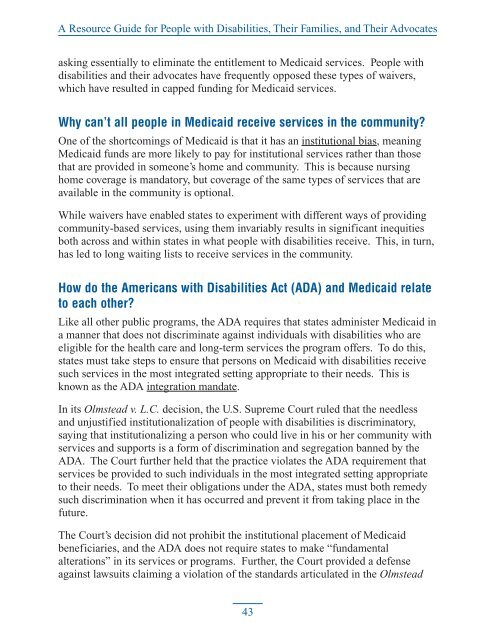Navigating Medicare and Medicaid, 2005: Full Report
Navigating Medicare and Medicaid, 2005: Full Report
Navigating Medicare and Medicaid, 2005: Full Report
Create successful ePaper yourself
Turn your PDF publications into a flip-book with our unique Google optimized e-Paper software.
A Resource Guide for People with Disabilities, Their Families, <strong>and</strong> Their Advocates<br />
asking essentially to eliminate the entitlement to <strong>Medicaid</strong> services. People with<br />
disabilities <strong>and</strong> their advocates have frequently opposed these types of waivers,<br />
which have resulted in capped funding for <strong>Medicaid</strong> services.<br />
Why can’t all people in <strong>Medicaid</strong> receive services in the community?<br />
One of the shortcomings of <strong>Medicaid</strong> is that it has an institutional bias, meaning<br />
<strong>Medicaid</strong> funds are more likely to pay for institutional services rather than those<br />
that are provided in someone’s home <strong>and</strong> community. This is because nursing<br />
home coverage is m<strong>and</strong>atory, but coverage of the same types of services that are<br />
available in the community is optional.<br />
While waivers have enabled states to experiment with different ways of providing<br />
community-based services, using them invariably results in significant inequities<br />
both across <strong>and</strong> within states in what people with disabilities receive. This, in turn,<br />
has led to long waiting lists to receive services in the community.<br />
How do the Americans with Disabilities Act (ADA) <strong>and</strong> <strong>Medicaid</strong> relate<br />
to each other?<br />
Like all other public programs, the ADA requires that states administer <strong>Medicaid</strong> in<br />
a manner that does not discriminate against individuals with disabilities who are<br />
eligible for the health care <strong>and</strong> long-term services the program offers. To do this,<br />
states must take steps to ensure that persons on <strong>Medicaid</strong> with disabilities receive<br />
such services in the most integrated setting appropriate to their needs. This is<br />
known as the ADA integration m<strong>and</strong>ate.<br />
In its Olmstead v. L.C. decision, the U.S. Supreme Court ruled that the needless<br />
<strong>and</strong> unjustified institutionalization of people with disabilities is discriminatory,<br />
saying that institutionalizing a person who could live in his or her community with<br />
services <strong>and</strong> supports is a form of discrimination <strong>and</strong> segregation banned by the<br />
ADA. The Court further held that the practice violates the ADA requirement that<br />
services be provided to such individuals in the most integrated setting appropriate<br />
to their needs. To meet their obligations under the ADA, states must both remedy<br />
such discrimination when it has occurred <strong>and</strong> prevent it from taking place in the<br />
future.<br />
The Court’s decision did not prohibit the institutional placement of <strong>Medicaid</strong><br />
beneficiaries, <strong>and</strong> the ADA does not require states to make “fundamental<br />
alterations” in its services or programs. Further, the Court provided a defense<br />
against lawsuits claiming a violation of the st<strong>and</strong>ards articulated in the Olmstead<br />
43

















